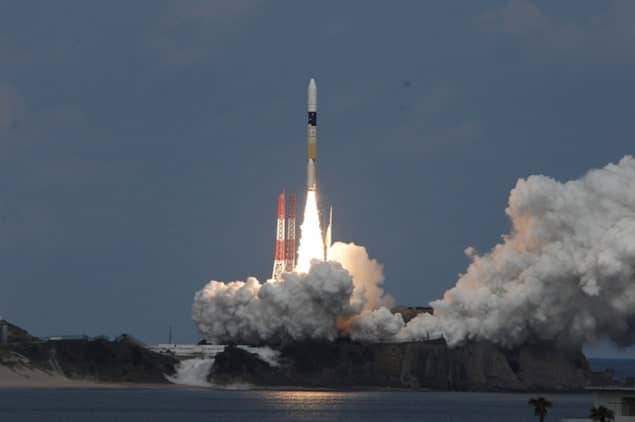
The Japanese space agency, JAXA, has launched the country’s second asteroid sample-return mission. Hayabusa 2 blasted off this morning at 1.22 p.m. local time (4.22 a.m. GMT) from the Tanegashima Space Centre in Japan, and will now spend two years travelling to asteroid 1999 JU3 – an almost spherical carbon-rich asteroid that is 920 m in diameter and is thought to contain organic matter and hydrated minerals. The probe will bring back a sample to Earth sometime in 2020.
Hayabusa 2 is a successor to Japan’s original Hayabusa craft, which returned with the first-ever samples from an asteroid back in 2010. Weighing almost 600 kg and costing about $250m, Hayabusa 2 will attempt to find out the origin of JU3’s organic matter and water, and how these are related to life and ocean water on Earth. The Space Activities Commission, which governs funding for the Japanese space programme, formally approved the Hayabusa 2 mission in January 2012.
The craft was launched when the asteroid’s path was at its closest to Earth, and Hayabusa 2 will eventually reach the body by the middle of 2018. The craft will then land on the asteroid and stay there for around 18 months to retrieve samples, before beginning its return journey to Earth in 2020. While the configuration and payloads for Hayabusa 2 are similar to the original mission – which only scraped the surface of the asteroid it landed on – the new craft will instead release a 2 kg impactor before touching down. The impactor will hit the asteroid’s surface and make a small crater several metres in diameter. Hayabusa 2 will then land in the crater to collect samples from within the asteroid.
Extraterrestrial grains
Japan will be hoping that Hayabusa 2 is as successful as its predecessor. Launched in 2003, Hayabusa was sent to the Itokawa asteroid – a 500 m-long body that lies about 300 million kilometres away from Earth. It was due to return in 2007 but, following a few technical glitches, including being hit by a solar flare, its return home was delayed by three years.
However, Hayabusa was still a success, with JAXA announcing last year that it had identified about 1500 grains as being extraterrestrial in origin. The recovered minerals include olivine, pyroxene, plagioclase and iron sulphide. Although these minerals are found on Earth, the composition of the grains, which were about 10 μm in diameter, matched the measurements taken by the X-ray spectrometer on board Hayabusa before the craft landed on Itokawa. This ruled out the possibility that the signal was contaminated by terrestrial materials after the probe landed back on Earth in the Australian outback.
The launch of Hayabusa 2 comes weeks after the European Space Agency’s Rosetta mission successfully put its Philae lander on the surface of a comet.



